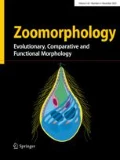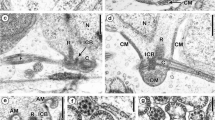Abstract
Acoel sperm characters proved useful in deciphering acoel taxonomy. The phylogenetic value of sperm characters in closely related sub-groups or in a monophyletic taxon has not yet been assessed. We have investigated sperm ultrastructure in seven members of the monophyletic taxon Childia sensu (Tekle et al. J Zool Sys Evol Res 43(1):72–90, 2005) and in their closest relatives, the Mecynostomidae (four taxa). All members of Childia examined show little variation in their sperm ultrastructure. The common characters of Childia taxa are: 9 + 1 axoneme structure, the presence of six distal cytoplasmic microtubules in the absence of axial or cortical ones, long nucleus and extensive nucleus–flagella overlap. We have identified a new set of cytoplasmic microtubules lying in the centriolar end of the sperm cell, distal microtubules. The origin and phylogenetic significance of this character is discussed. The types and arrangement of cytoplasmic granules could be used as phylogenetic characters at a low taxonomic level. A loose membrane amorphous core type of granule was found to be a synapomorphy for the following clade within the taxon Childia: C. crassum + C. groenlandica + C. vivipara + C. brachyposthium + C. macroposthium. Sausage shaped granules are plesiomorphic among the taxa examined. The rest of the granule characters were found to be homoplasious. Sperm ultrastructural characters have again proven their concordance with molecular phylogeny. The only morphological synapomorphies known for the sister taxa Childia–Mecynostomidae, in the molecular phylogeny, are characters derived from sperm ultrastructure: distal microtubules arranged in two groups of three microtubules each and a 9 + 1 axoneme structure. The spermatozoa of Childia and Mecynostomidae show 9 + 1 axoneme configuration, seemingly similar to the 9 + ‘1’ axoneme pattern of the Platyhelminthes—Trepaxonemata. Using electron-microscope immunocytochemistry, we have demonstrated that, unlike the central cylinder of trepaxonematans, the central cylinder of the 9 + 1 axonemal pattern in acoels is immunoreactive to tubulin and contains a single central microtubule. Therefore, the 9 + 1 patterns in acoels and trepaxonematans are homoplasious.







Similar content being viewed by others
References
Afzelius BA (1966) Anatomy of the cell. University of Chicago Press, Chicago, pp 127
Afzelius BA (1982) The flagellar apparatus of marine spermatozoa. Evolutionary and functional aspects. In: Amos WB, Duckett JG (eds) Prokaryotic and eukaryotic flagella. Cambridge University Press, Chicago, pp 495–519
Baccetti B, Afzelius BA (1976) The biology of the sperm cell. Monogr Dev Biol 10:1–254
Blose SH, Meltzer DI, Feramisco JR (1984) 10 nm filaments are induced to collapse in living cells microinjected with monoclonal and polyclonal antibodies against tubulin. J Cell Biol 98:847–858
Dörjes J (1968) Die Acoela (Turbellaria) der deutschen Nordseeküste und ein neues System der Ordnung. Z Zool Syst Evolut Forsch 6:56–452
Gozes I, Barnstable CJ (1982) Monoclonal antibodies that recognize discrete forms of tubulin. Proc Natl Acad Sci USA 79:2579–2583
Hendelberg J (1969) On the development of different types of spermatozoa from spermatids with two flagella in the Turbellaria with remarks on the ultrastructure of the flagella. Zool Bidr Uppsala 38:1–50
Hendelberg J (1977) Comparative morphology of turbellarian spermatozoa studied by electron microscopy. Acta Zool Fenn 154:149–162
Henley C, Costello DP, Thomas MB, Newton WD (1969) The ‘9 + 1’ pattern of microtubules in spermatozoa of Mesostoma (Plathelminthes, Turbellaria). PNAS 64:849–856
Henley C (1974) Platyhelminthes (Turbellaria). In Giese AC, Pearse JS (eds) Reproduction of marine invertebrates, vol I. Acoelomates and pseudocoelomate Metazoans. Academic, New York, pp 267–343
Hooge MD, Tyler S (1999) Body-wall musculature in Praeconvoluta tornuva, n. sp. and the use of muscle patterns in taxonomy of acoel turbellarians. Invertebr Biol 118:8–17
Hooge MD (2001) Evolution of body-wall musculature in the Platyhelminthes (Acoelomorpha, Catenulida, Rhabditophora). J Morphol 249:171–194
Hooge MD, Haye PA, Tyler S, Litvaitis MK, Kornfield I (2002) Molecular systematics of the Acoela (Acoelomorpha, Platyhelminthes) and its concordance with morphology. Mol Phylog Evol 24:333–342
Jondelius U, Ruiz-Trillo I, Baguna J, Ruitort M (2002) The Nemertodermatida are basal bilaterians and not members of the Platyhelminthes. Zool Scr 31:201–215
Iomini C, Raikova O, Noury-Sraïri N, Justine J-L (1995) Immunocytochemistry of tubulin in spermatozoa of Platyhelminthes. In: Jamieson BGM, Ausio J, Justine J-L (eds) Advances in spermatozoal phylogeny and taxonomy, vol 166. Paris, Memoires du Museum National d’Histoire Naturelle, pp 97–104
Piperno G, Fuller MT (1985) Monoclonal antibodies specific for an acetylated form of alpha-tubulin recognize the antigen in cilia and flagella from a variety of organisms. J Cell Biol 101:2085–2094
Petrov A, Hooge MD, Tyler S (2004) Ultrastructure of sperms in Acoela (Acoelomorpha) and its concordance with molecular systematics. Invertebr Biol 123:183–197
Raikova OI, Justine J-L (1994) Ultrastructure of spermiogenesis and spermatozoa in three Acoels (Platyhelminthes). Ann Sci Nat (Zool) 15:63–75
Raikova OI, Flyatchinskaya LP, Justine J-L (1998) Acoel spermatozoa: ultrastructure and immunocytochemistry of tubulin. Hydrobiologia 383:207–214
Raikova OI, Justine J-L (1999) The microtubular system during spermiogenesis and in the spermatozoon of Convoluta saliens (Platyhelminthes, Acoela): tubulin immunocytochemistry and electron microscopy. Mol Reprod Dev 52:74–85
Raikova OI, Reuter M, Justine J-L (2001) Contributions to the phylogeny and systematics of the Acoelomorpha. In: Littlewood DTJ, Bray RA (eds) Interrelationships of the Platyhelminthes. Taylor and Francis, London, pp 13–23
Rohde K, Watson N, Cannon LRG (1988) Ultrastructure of spermiogenesis in Amphiscolops (Acoela, Convolutidae) and of sperm in Pseudactinoposthia (Acoela, Childiidae) J Submicrosc Cytol Pathol 20:595–604
Ruiz-Trillo I, Riutort M, Littlewood DTJ, Herniou EA, Baguna J (1999) Acoel flatworms: earliest extant bilaterian metazoans, not members of Platyhelminthes. Science 283:1919–1923
Silveira M (1969) Ultrastructural studies on a ‘nine plus one’ flagellum. J Ultrastruct Res 26:274–288
Silveira M (1975) The fine structure of 9 + 1 flagella in turbellarian flatworm. In: Afzelius BA (ed) The functional anatomy of the spermatozoon. Pergamon Press, Oxford, pp 289–298
Tekle YI, Raikova OI, Ahmadzadeh A, Jondelius U (2005) Revision of the Childiidae (Acoela), a total evidence approach in reconstructing the phylogeny of acoels with reversed muscle layers. J Zool Sys Evol Res 43(1):72–90
Thomas MB (1975) Transition structure of the 9 + 1 axonemal core as revealed by treatment with trypsin. J Ultrastr Res 52:409–422
Tyler S, Hyra GS (1998) Patterns of musculature as taxonomic characters for the Turbellaria Acoela. Hydrobiologia 383:51–59
Tyler S, Rieger RM (1999) Functional morphology of musculature in the acoelomate worm, Convoluta pulchra (Plathelminthes). Zoomorphology 119:127–141
Tyler S, Schilling S, Hooge MD, Bush LF (comp) (2005) Turbellarian taxonomic database. Version 1.4 http://www.devbio.umesci.maine.edu/styler/turbellaria/
Westblad E (1942) Studien über skandinavische Turbellaria Acoela. II. Ark Zool 33A(14):1–48
Acknowledgments
We are grateful to Annete Axén, Stefan Gunnarsson, and Gary Wife for technical assistance. Thanks are extended to the staff of the marine biological stations at Kristineberg, Tjärnö (Sweden), and Cape Kartesh (Russia) for their help with collecting the material. This study was supported by the Asmara Program at ISP, Uppsala University and SIDA/SAREC (Y. Tekle). Additional financial support was received from the Swedish Research Council (U. Jondelius), the Royal Swedish Academy (U. Jondelius and O. Raikova), and the Russian Foundation for Basic Research grant 06-04-48053 (O. Raikova).
Author information
Authors and Affiliations
Corresponding author
Rights and permissions
About this article
Cite this article
Tekle, Y.I., Raikova, O.I., Justine, JL. et al. Ultrastructural and immunocytochemical investigation of acoel sperms with 9 + 1 axoneme structure: new sperm characters for unraveling phylogeny in Acoela. Zoomorphology 126, 1–16 (2007). https://doi.org/10.1007/s00435-006-0023-z
Received:
Accepted:
Published:
Issue Date:
DOI: https://doi.org/10.1007/s00435-006-0023-z




